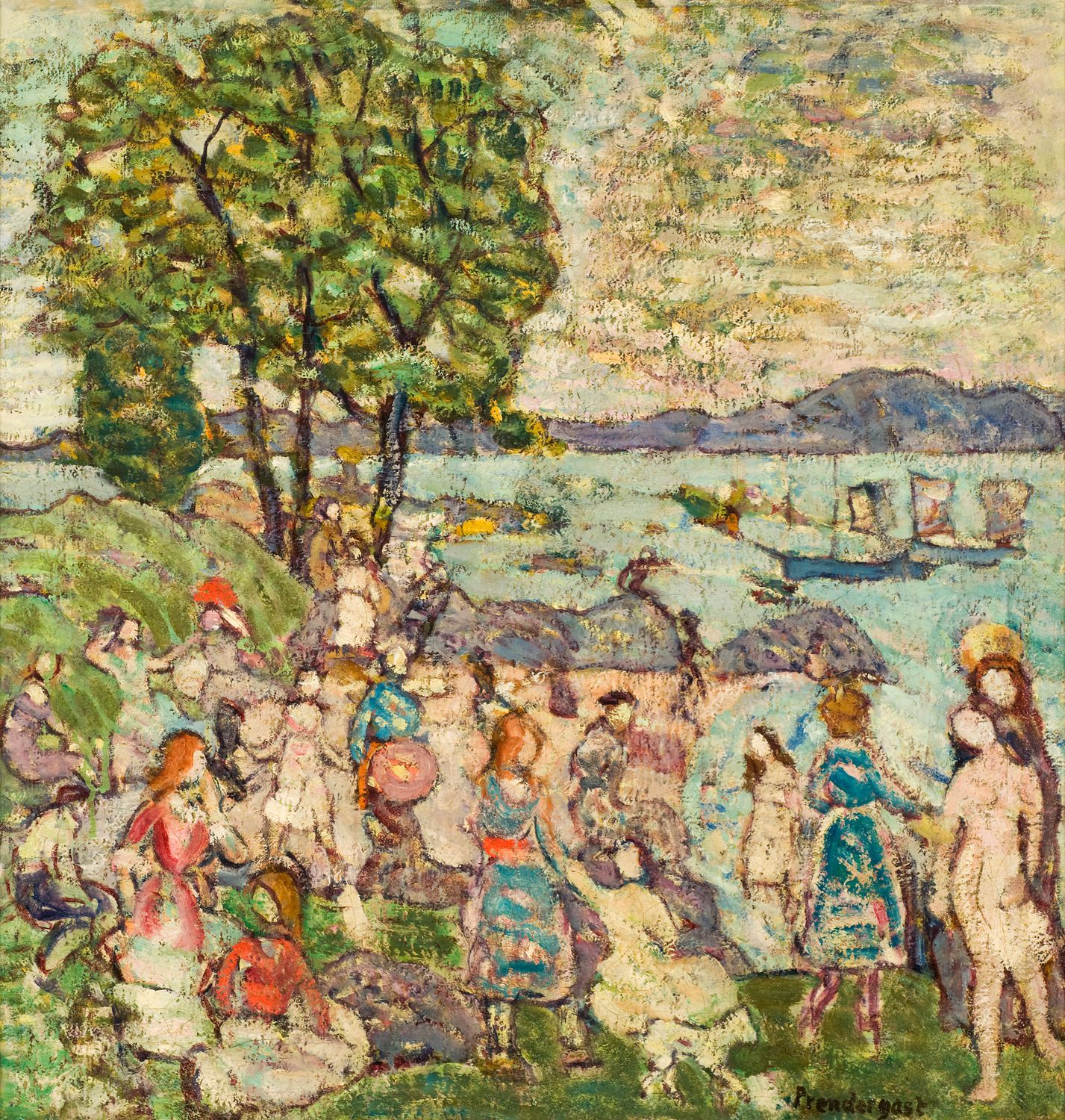
The Bathing Cove
Article Published by: reynoldahouse.org
With The Bathing Cove, circa 1918, the American modernist Maurice Prendergast continued to explore a theme that had preoccupied him for decades: groups of figures, decoratively arranged into a frieze-like formation, in a bucolic outdoor setting.
Here, bathers are gathered on a grassy knoll by the water’s edge, while sailboats bob in the distance. Like an earlier generation of artists, the Impressionists, Prendergast was attracted to scenes of leisure painted outdoors, but his nearly abstract forms and flattened perspective are evidence of his avant-garde style.
Executed late in the artist’s career, The Bathing Cove is representative of much of Prendergast’s work at the time. The figures are just barely suggested by carefully arranged patches of color rather than fully articulated features and forms. Prendergast further emphasized these discrete patches of greens, blues, reds, pinks, and creams by outlining each section with dark, heavy lines, giving the painting the feeling of stained glass.
The composition is made up of separate horizontal bands: foreground (land and figures), middle ground (water and boats), and background (hills, sky, and trees). The artist has flattened the perspective so that the viewer perceives these areas as stacked on top of each other rather than receding realistically into the distance. The viewer’s sense of spatial recession comes from the overlapping of forms and from the hieratic perspective: the lowest forms are the closest. Prendergast’s emphasis on the flatness and two-dimensionality of the canvas, strengthened by the painting’s nearly square format, marks him as a modernist.
In addition, Prendergast makes no attempt to disguise his brushstroke. Instead, he lays the paint on thickly, creating a rough surface, and reminding the viewer that the object before him is a painting rather than a glimpse of reality. In this way, Prendergast demonstrated how far his painting style had evolved from the academic styles of his instructors at the Académie Julian. He more closely aligns himself with artists such as the post-Impressionists Vincent Van Gogh and Paul Gauguin, and Fauvist Henri Matisse, whose work he had seen at the Armory Show in 1913.
The Bathing Cove also calls to mind the work of another group of European painters, the Symbolists, whose subject matter tended toward the dreamy and otherworldly. There is a lyrical quality to the painting that sets it apart from Prendergast’s other contemporary urban scenes. Further, the painting includes enigmatic religious motifs that are unusual in Prendergast’s work: the three trees, symbolic of the trinity, a white lamb in the foreground, and, most surprising of all, a pietà in the lower right corner. [1] The Bathing Cove, painted toward the end of Prendergast’s life, is perhaps the work of an artist who was beginning to contemplate his own mortality.
About Scott Livengood
Scott Livengood is the owner and CEO of Dewey’s Bakery, Inc., a commercial wholesale bakery with a respected national brand of ultra premium cookies and crackers.
Previously, Scott worked at Krispy Kreme Doughnuts for 27 years, starting as a trainee in 1977. He was appointed President of the company in 1992, then CEO and Chairman of the Board.
Scott has served on numerous boards including the Carter Center, the Calloway School of Business and the Babcock School of Management, Habitat for Humanity of Forsyth County, and the Winston-Salem Chamber of Commerce.
He started a new business, StoryWork International, in 2016 with Richard Stone. The signature achievement to date is LivingStories, a story-based program for improved patient experiences and outcomes in partnership with Novant Health.




